Sun news April 20: Auroral displays! Strong geomagnetic storm reached G3 level
Sun news for April 20, 2024: Strong geomagnetic activity. Level reached G3
Today’s top story: A surprising strong geomagnetic storm was registered late yesterday. G3 level or Kp index = 7 was observed. Threshold was reached at 19:51 UTC. This occurred after a gigantic humongous prominence occurred yesterday on the southeast limb (edge) on our star. These two events are not related though. After the strong geomagnetic activity, auroral display reached north latitudes as far south as the states of Pennsylvania to Iowa to Oregon in the US. Did you see auroras? Share your beautiful photos with us! Send them to our EarthSky Community Photos here. The surprising strong G3 magnetic storm was the result of the arrival of a coronal mass ejection (CME) combined with fast solar wind from a coronal hole. Conditions are back to quiet to unsettled. Keep tuned.
Last 24 hours: Sun flaring production increased from 12 flares the previous period up to 20 flares in total in the past day. An isolated faint M1.0 flare, the largest of our observation period between 11 UTC yesterday and 11 UTC today, keeps the sun activity at moderate levels. The M1.0 event was blasted by active region AR3638 at 13:06 UTC on April 19. Shortly after the flare an R1 (minor) radio blackout was observed affecting an area over the Atlantic Ocean off the northeast coast of Africa. Lead flare producer during the period was active region AR3638 producing nine flares, the M included. The sun bears today 14 numbered active regions on its Earth-facing side, one of the largest numbers of sunspot regions on the solar disk of this Solar Cycle 25. AR3639 lost its beta-gamma magnetic configuration same as AR3647 that was showing a beta-delta lost it to show an alpha configuration. Attracts our attention that all the active regions on the solar disk are showing alpha magnetic configuration. showing stable or either in decay. The sun granted us with three newcomer active regions numbered during the past day, now labeled AR3649, AR3650 and AR3651. AR3648 was numbered but rapidly decayed.
Next 24 hours: The chance for C flares is 99%. The chance for M flares is 75%. Chances for an X flare are 20%.
Next expected CME: The coronal mass ejections (CMEs) hurled into space associated with yesterday’s gigantic prominence from the erupting filament on the southeast limb (edge), no component Earth-bound was observed. No other Earth-directed CMEs were observed in the available imagery.
Current geomagnetic activity: Earth’s magnetic field is quiet at the time of this writing (11 UTC on April 20). A strong G3 geomagnetic storm was observed late yesterday. Kp=7 threshold was reached at 19:51 UTC. This was in response to coronal mass ejection (CME) activity combined with effects of fast-speed solar wind from a coronal hole. Quiet to unsettled conditions are expected for the rest of the day today extended thru tomorrow due to continued CME activity.

Sun news for April 19, 2024: Humongous prominence!
Today’s top story: The sun let out a HUGE burp today – a burp of solar plasma that dwarfed planet Earth! It came in the form of a gigantic solar prominence. These long ropes of solar material are called filaments when observed on the solar disk, and prominences when they hang over the sun’s limb (edge), as this one did. The material comes from the chromosphere – our star’s lower atmosphere – and is 80,000 kelvin (143,000 °F). Think that’s hot? Well, this material is suspended by magnetic fields in the corona (the upper atmosphere) which is over a million kelvin (over 1.8 million °F)! Sometimes these prominences become unstable and erupt away from the sun in the form of coronal mass ejections (CMEs), which can cause auroras if they collide with Earth. But sometimes they simply fall back to the sun, or even just dissipate. As you can see in the GOES-R spacecraft imagery, this one largely dissipated. But there might also be a CME; we will have to wait for data from the SOHO spacecraft to be sure. Either way, wow! That was humungous.
Last 24 hours: We’ve got more great imagery today; the STEREO-A spacecraft’s heliospheric imager, H1, captured the comet 12P/Pons-Brooks having its tail pulled away last week by the passing of a CME. These are known as disconnection events, made famous by STEREO observations of Comet Enke, April 2007. Meanwhile on the sun, flaring activity remains moderate. Between 11 UTC yesterday and 11 UTC today, the sun produced 12 flares – a decrease from the previous day – including three M flares. The largest event was an M2.1 flare from sunspot region AR3647 at 4:53 UTC on April 19. It caused an R1 (minor) radio blackout off the east coast of Vietnam. The other two Ms were nearly simultaneous M1.6 flares from AR3643, one at 20:01 UTC and one at 20:16 UTC on April 18. These two flares caused R1 radio blackouts over the Pacific Ocean between Hawaii and the west coast of Baja California, Mexico. Six active regions produced flares, with AR3643 and AR3645 producing the most at three each. AR3639 has a beta-gamma magnetic configuration and AR3647 is showing beta-delta. These two regions have the best chance for major flares, with a delta region indicating the greatest complexity and potential. The sun has 13 active regions on its Earth-facing side, including the addition of a newcomer: AR3647.
Next 24 hours: The chance for C flares is 99%. The chance for M flares is 75%. Chances for an X flare are 20%.
Next expected CME: The coronal mass ejections (CMEs) observed from the erupting filament yesterday in the southeast quadrant may provide a glancing blow at Earth on April 21–22. No other Earth-directed CMEs were observed in the available imagery.
Current geomagnetic activity: Earth’s magnetic field is unsettled at the time of this writing (11 UTC on April 19.) A Kp=4 level was reached at 7:50 UTC. Unsettled conditions may be extended through the rest of the day, and unsettled-to-active conditions are expected tomorrow. This is mainly due to the effects of fast-speed solar wind from a coronal hole.
Sun news for Apr 19, 2024: Humongous prominence!
The sun let out a big burp of solar plasma that dwarfed the planet Earth!
Flaring on the sun continues at moderate levels.
STEREO-A H1 saw comet 12P have its tail pulled away by a CME.
MORE at EarthSky: https://t.co/xD29wLfm4e pic.twitter.com/iQuGDLFDgT
— Dr. C. Alex Young (@TheSunToday) April 19, 2024
Sun news for April 18, 2024: Cluster of sunspot regions firing jets and flares
? ?Sun news for Apr 18, 2024: A cluster of sunspot regions firing jets and flares
?Three M flares kept sun activity at moderate levels.
?Some jets extend to nearly the sun’s radius, over 400,000 miles, or 50+ Earths back to back.
MORE at EarthSky: https://t.co/xD29wLfm4e pic.twitter.com/ebQhE8DlB3
— Dr. C. Alex Young (@TheSunToday) April 18, 2024
Our star is currently covered in active sunspot regions, and a huge cluster in the southeast has been grabbing our attention. It’s been the source of most of the past day’s flares, as well as a near-continuous volley of plasma jets into space. Some of these jets extend to nearly the radius of the sun – over 400,000 miles – or the length of over 50 Earths back to back! And this cluster hasn’t been the only source of action. We’ve also been watching many prominences – long ropes of solar material and magnetic fields – billowing around the sun’s limb (edge), including a particularly long one spiraling off the north pole. It’s been a beautiful “sunny day” on our star as it reaches solar maximum.
Last 24 hours: Between 11 UTC yesterday and 11 UTC today, the sun produced 25 flares: three M flares and 22 Cs. That means activity remains at moderate. The largest event was an M2.2 flare from sunspot region AR3638 at 2:48 UTC on April 18. It caused an R1 (minor) radio blackout to the east of the Philippines. The other two Ms were an M1.6 from AR3645 at 22:08 UTC on April 17 and an M1.1 from AR3645 at 7:37 UTC on April 18. The first of these caused an R1 radio blackout over an area south of Hawaii, while the other produced an R1 blackout affecting an area over the Indian Ocean off the southwest coast of India. Three active regions – AR3639, AR3643, and AR3645 – are now showing potential with beta-gamma magnetic configurations. AR3639 lost its high potential delta region, but is still showing the potential for more flaring. The lead flare producer of the past day was AR3645 with 12 flares. The sun currently has 12 active regions on its Earth-facing side, including two newcomers: AR3645 and AR3646.
Sun news for April 17, 2024: Auroras today and more tomorrow
The EarthSky sun news team created this 1-minute video summary for you. Filament eruptions and auroras!Several coronal mass ejections (CMEs) have struck Earth, producing beautiful auroral displays! A G1 (minor) geomagnetic storm was registered late yesterday, and this magnetic disturbance is anticipated to extend for the rest of the day. It may even increase to a G2 (moderate) storm as more CMEs arrive, ones hurled by the sun on April 14-15. And there may be even more to come; a couple of fiery filament eruptions were observed over the past day – one in the southeast, and one just above the equator – which may have sent more sun-stuff our way. We’ll update you when modeling and analysis is complete.
Last 24 hours: The sun produced 17 flares during the past day: one M flare and 16 Cs. This keeps sun activity at moderate levels. The largest event recorded between 11 UTC yesterday and 11 UTC today was an M1.1 flare from sunspot region AR3637 at 18:02 UTC on April 16. A corresponding R1 (minor) radio blackout occurred, affecting an area over the Caribbean. The lead flare producer of the period was AR3639 with eight C flares. This region showed growth during the past day and gained delta complexity, now showing a beta-gamma-delta magnetic configuration. This means this sunspot has the potential to produce more M and even X flares. Slightly less potent but still showing promise are AR3637 and AR3643, showing beta-delta and beta-gamma magnetic complexities, respectively. The sun currently has 11 active regions on its Earth-facing side, including newcomer AR3644 on the northeast limb (edge).
? ? Sun news for April 17, 2024: Auroras today and more tomorrow
? ? Coronal mass ejections (CMEs) arrived, creating conditions for auroral displays.
? ? A couple of fiery filament eruptions were observed during the period.
? MORE at EarthSky: https://t.co/xD29wLfm4e pic.twitter.com/TASwm9ax75
— Dr. C. Alex Young (@TheSunToday) April 17, 2024
Sun news for April 16, 2024: Now we’re talkin’! 4 more M flares!
The EarthSky sun news team created this 1-minute video summary for you. 4 more Ms!In recent weeks, it seemed almost as if the sun were asleep. Despite the fact that the sun is entering solar maximum, the peak of its 11-year cycle of activity, we witnessed an extended period of calm. But now it looks like the lull is over! The sun fired four M flares over the past day, along with 16 C flares. That’s in addition to the 4 M flares it had fired the day before that. Plus, fiery filament activity continues on the Earth-facing disk, with more activity observed as prominences overhanging the northeast limb (edge). This indicates that an active region just beyond the northeast horizon should rotate into view over the next couple of days, potentially adding to the resurgence in solar activity we’re currently seeing. Stay tuned!
Last 24 hours: Sun activity is moderate after four M flares were observed in the past day. The sun produced 20 flares overall, with 16 C flares adding to the Ms. The largest was an M4.0 flare from sunspot region AR3639 in the northeast. It was produced at 19:32 UTC on April 15. Here’s a list of the M flares produced between 11 UTC yesterday and 11 UTC today:
1. M1.5 by AR3634 at 14:04 UTC on April 15
2. M1.1 by AR3639 at 13:58 UTC on April 15
3. M2.2 by AR3639 at 14:17 UTC on April 15
4. M4.0 by AR3639 at 19:32 UTC on April 15
After each M flare, a corresponding R1 (minor) radio blackout occurred over the sun-facing portion of the Earth. The lead flare producer of the period was AR3639, which produced eight flares: three Ms, including the largest, and five Cs. This region has retained its beta-gamma magnetic configuration. The sun has 10 active regions on its Earth-facing side now.
? ? Sun news for April 16, 2024: Solar activity continues to rise
? ? For a while, it seemed like the sun was asleep. After the past week, that appears to have passed.
? The sun has been moderately active for several days.
? MORE at EarthSky: https://t.co/xD29wLfm4e pic.twitter.com/ojcXy2xOMg
— Dr. C. Alex Young (@TheSunToday) April 16, 2024
Sun news for April 15, 2024: Solar activity surge?, high number of sunspot regions and filaments
The sun is peppered with sunspot groups and filaments line the disk, poking out into space as prominences. All this goes along with an overall increase in activity. The flare-related sun activity remains at moderate levels. Filaments across the sun have erupted, or at least an attempt has been made. GOES X-ray monitor recorded 4 small-size M flares (less than M5) and Solar Dynamics Observatory (SDO) observations showed a variety of filament fun. Two noticeable filaments are an eruption from the southeast. Best observed in SDO 304 angstrom light, the filament erupts, and then the faint dark wave of material is visible heading northwest. The prominence on the western limb stirs, looking like it is going to erupt, and starts to send material into space, but instead the solar plasma rains back down upon the surface. Despite not yet reaching high activity levels, there is a marked increase in activity, so we may be seeing the beginning of another surge in sun action. Stay tuned!
Last 24 hours: Moderate sun activity continues as overall flare number is on the rise. During the past day (11 UTC yesterday to 11 UTC today), the sun produced 26 flares, 22 C flares, and 4 M flares. The largest event was an M2.4 at 3:38 UTC from AR3634 on April 15. The other M flares were an M1.7, an M1.0, and an M1.2. All four M flares produced radio blackouts over the sun-facing portion of the Earth. The sun has 12 active regions on its Earth-facing side now.
? ? Sun news for April 15, 2024: Solar activity surge? high number of sunspot regions and filaments
?? ? ? The sun is peppered with sunspot groups, and filaments line the disk, poking out into space as prominences.
? MORE at EarthSky: https://t.co/xD29wLfm4e pic.twitter.com/gZ1GS08lBl
— Dr. C. Alex Young (@TheSunToday) April 15, 2024
The sun in recent days
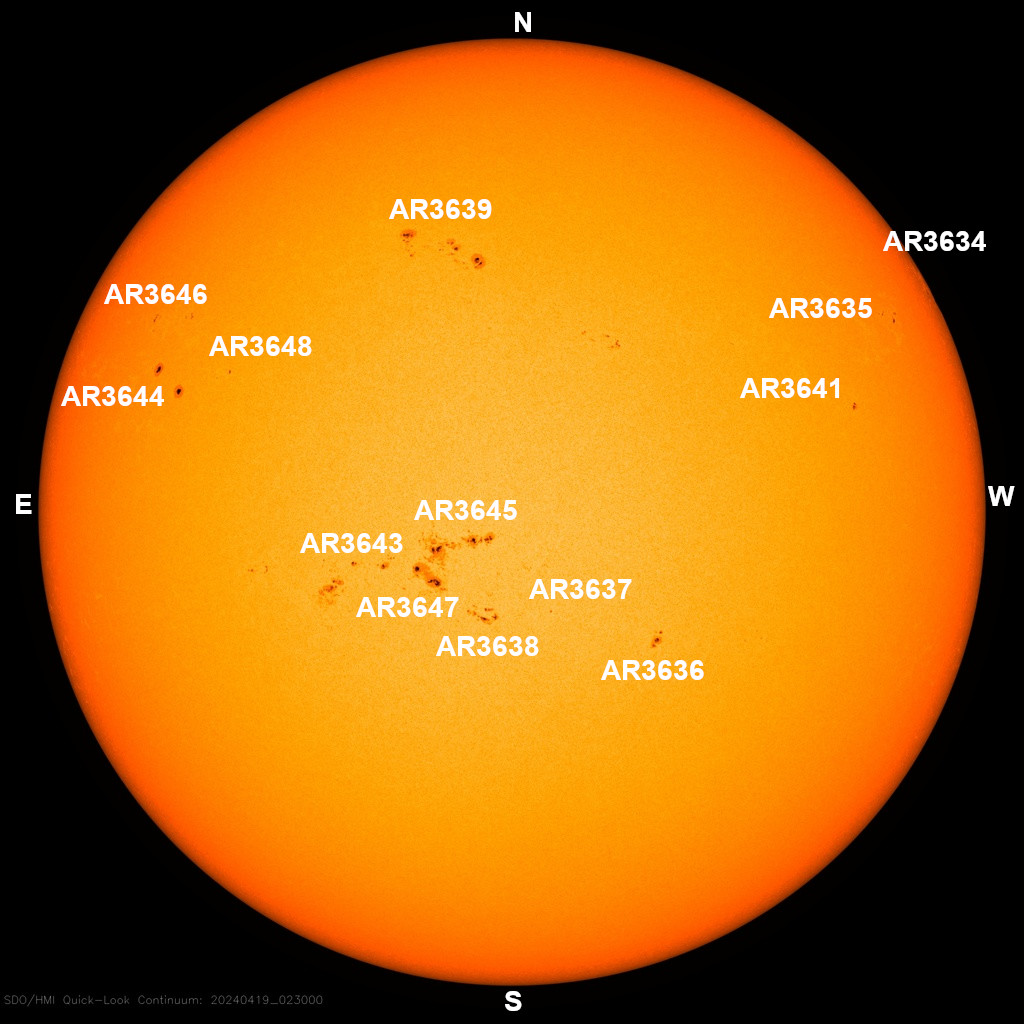

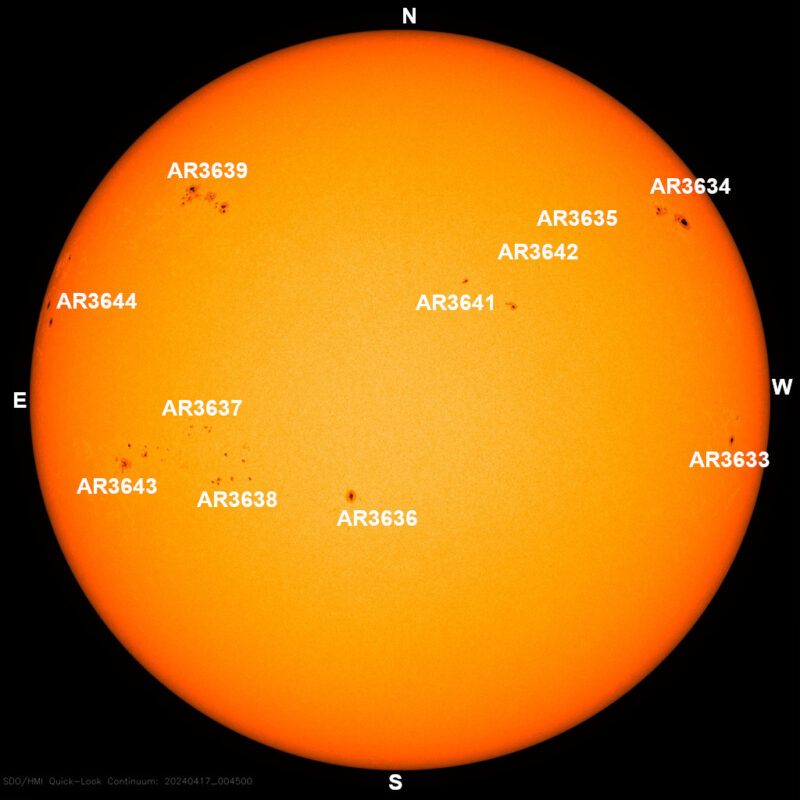
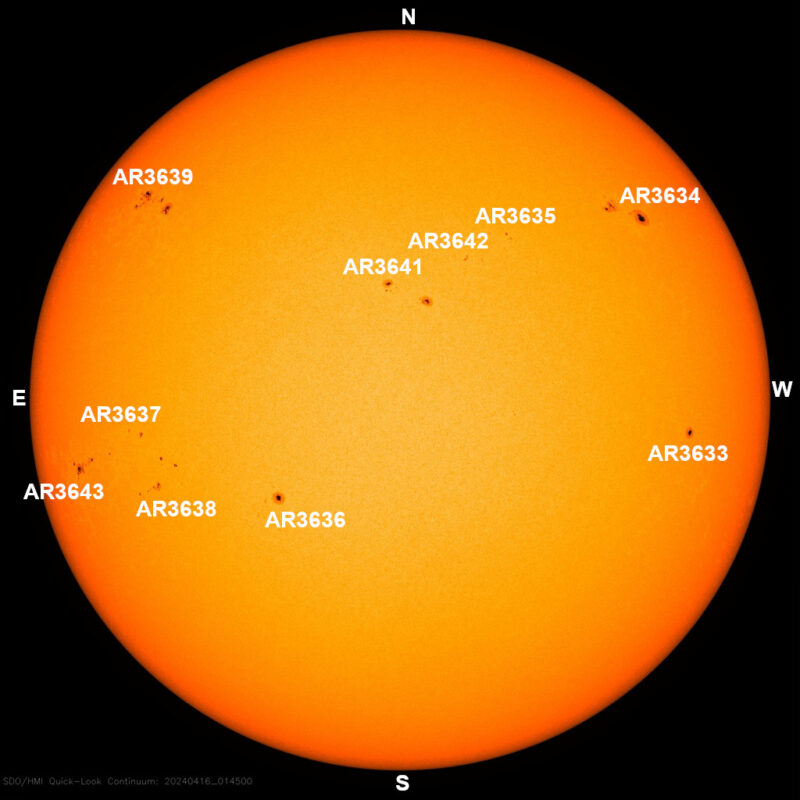
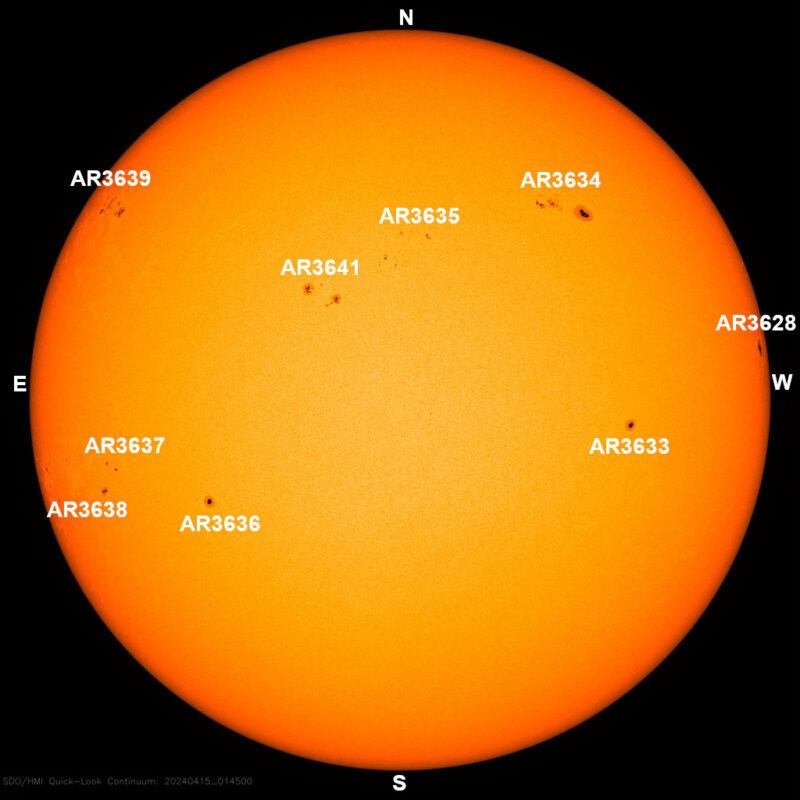
caption id=”attachment_471690″ align=”alignnone” width=”800″]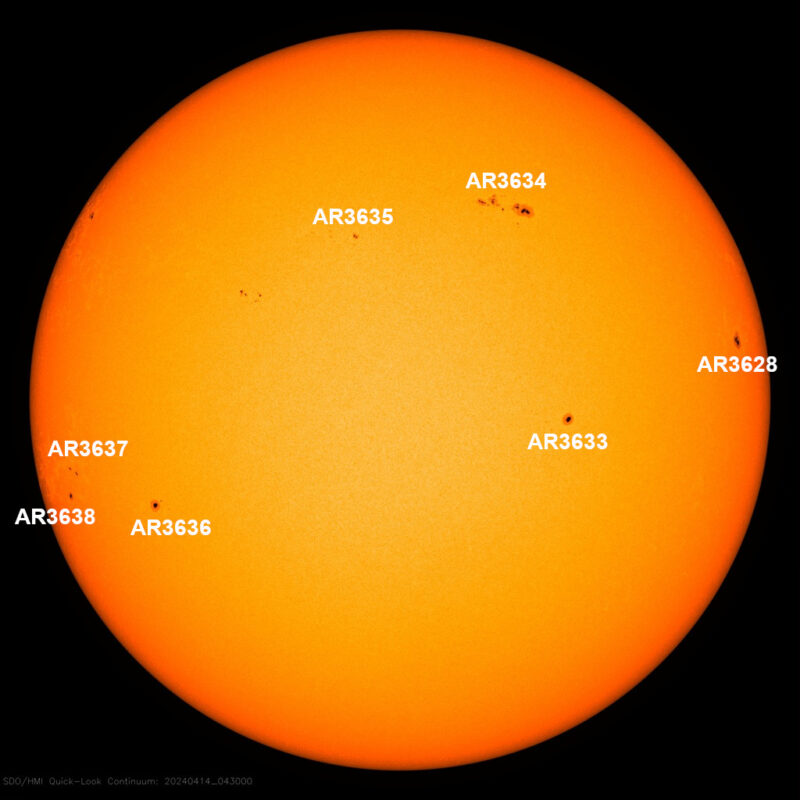 This image shows sun activity – with the most active regions labeled – as of 4 UTC on April 14, 2024. Courtesy of NASA/ SDO and the AIA, EVE, and HMI science teams, with labeling by EarthSky.[/caption]
This image shows sun activity – with the most active regions labeled – as of 4 UTC on April 14, 2024. Courtesy of NASA/ SDO and the AIA, EVE, and HMI science teams, with labeling by EarthSky.[/caption]

Sun images from our community
Are you a fan of sun images? We invite you all to send us your beautiful recent photos of sunspots and auroras. We love receiving them and sharing them! And to those of you who’ve already posted a photo to our community page, thank you.
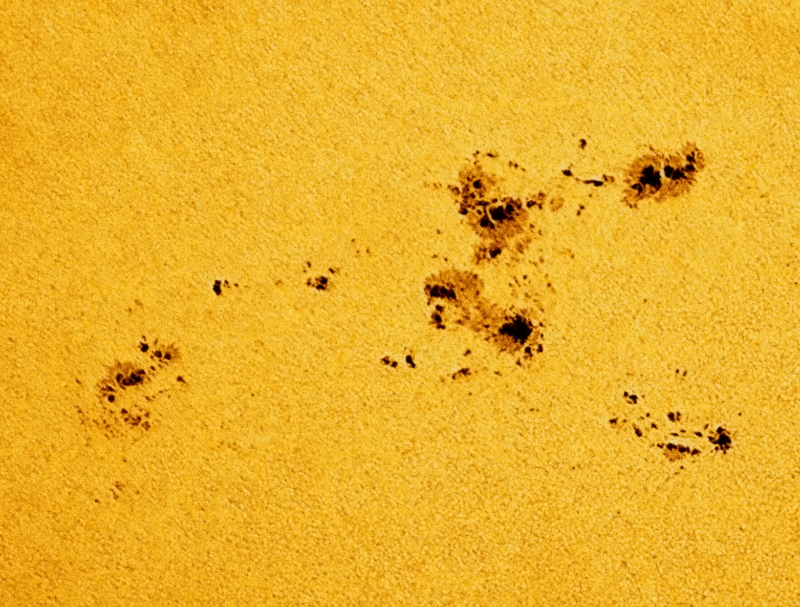
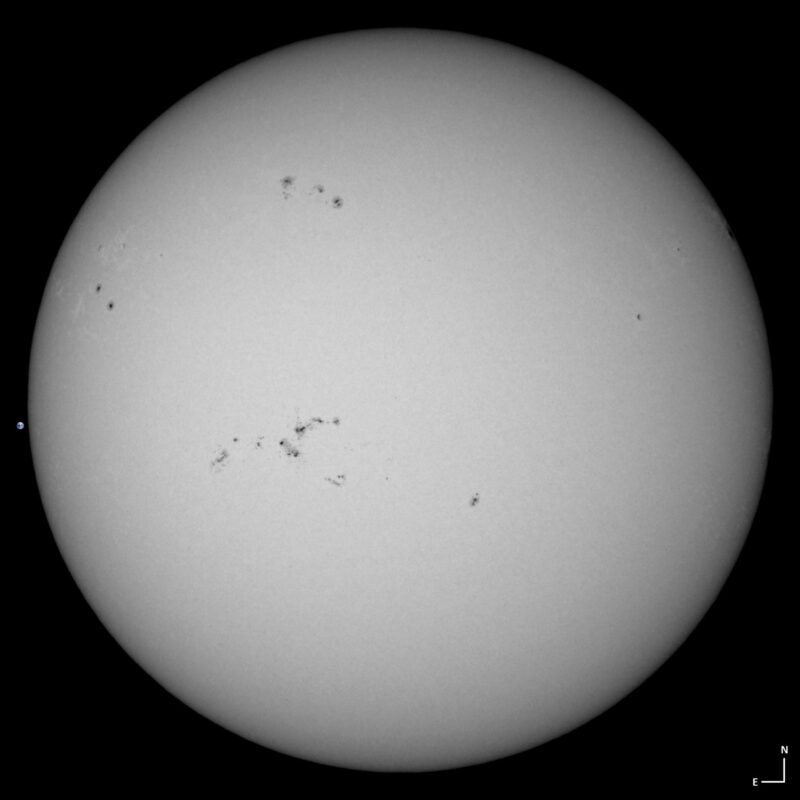

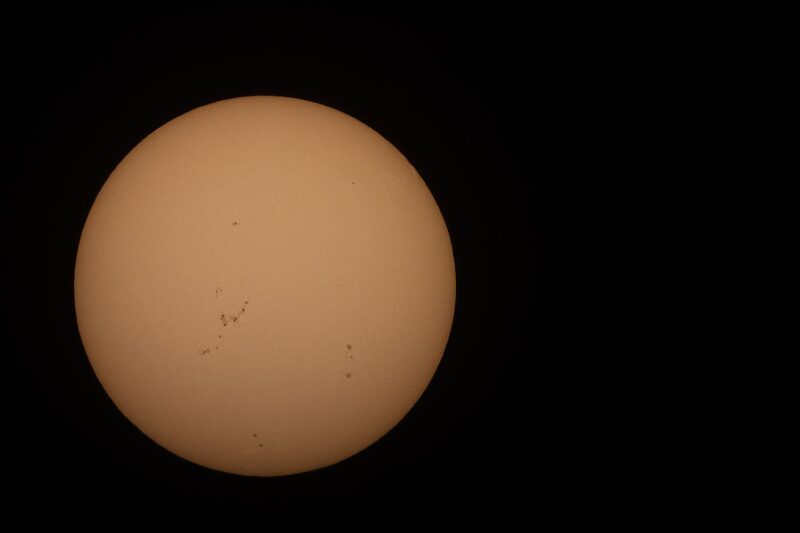
Bottom line: April 18, 2024, sun news. Wow! The sun blasted an absolutely enormous prominence, while a trio of M flares kept activity moderate.











